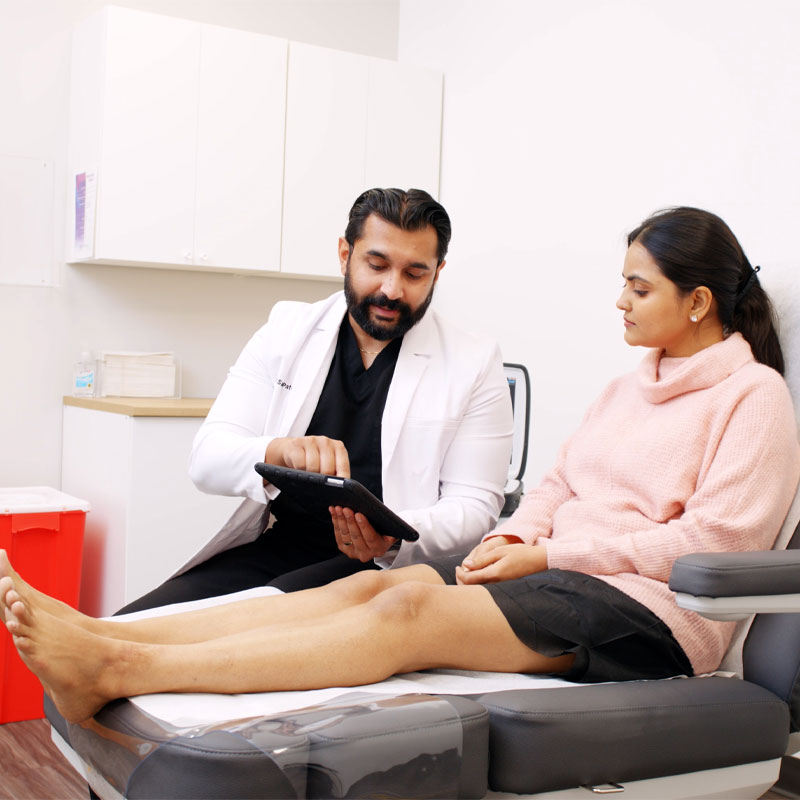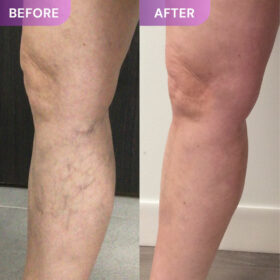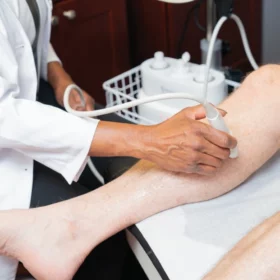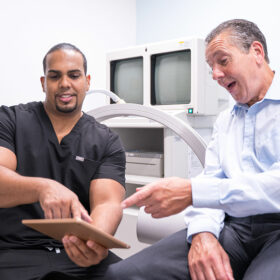At Vein Treatment Clinic, we understand the importance of maintaining optimal vein health to ensure an active lifestyle. As board-certified vein doctors, we are committed to providing comprehensive care and guidance to our patients, empowering them with the knowledge and tools to promote vein health and prevent complications. One of the most effective ways to achieve this is through regular exercise. In this article, we explore the benefits of exercise for vein health and prevention, offering valuable insights to help you improve your vein health.
Benefits of Exercise for Vein Health & Prevention
1. Enhanced Circulation
Exercise promotes healthy blood circulation throughout the body. When you engage in physical activity, your muscles contract and relax, acting as pumps that facilitate the movement of blood back to the heart. This rhythmic contraction and relaxation action, coupled with the increased heart rate during exercise, helps to propel blood through the veins more efficiently, reducing the risk of blood pooling and the formation of varicose veins and spider veins.
Furthermore, regular exercise stimulates the production of nitric oxide, a molecule that helps dilate blood vessels, improving blood flow and lowering blood pressure. By incorporating cardiovascular exercises such as walking, jogging, cycling, or swimming into your routine, you can effectively enhance circulation and support vein health.
2. Strengthened Vein Walls
Another significant benefit of exercise for vein health is its ability to strengthen the walls of the veins. Vein walls can become weakened over time due to various factors such as aging, genetics, prolonged sitting or standing, and obesity. Weak vein walls are more prone to stretching and bulging, leading to the development of varicose veins.
By engaging in resistance training and strength-building exercises, such as weightlifting, yoga, or Pilates, you can increase muscle mass and tone, which provides support to the veins. Stronger muscles exert pressure on the veins, helping to maintain their shape. This reduces the likelihood of vein wall damage and minimizes the risk of varicose vein formation.
3. Weight Management
Maintaining a healthy weight is crucial for overall vein health and preventing chronic venous insufficiency. Excess weight puts additional strain on the veins, especially those in the legs, increasing the risk of varicose veins and deep vein thrombosis (DVT). Furthermore, obesity is often associated with a sedentary lifestyle, which further exacerbates circulatory issues.
Regular exercise is instrumental in weight management and achieving a healthy body mass index (BMI). By burning calories and building lean muscle mass, exercise helps to boost metabolism and promote fat loss. Additionally, physical activity curbs appetite, reduces cravings, and improves insulin sensitivity, all of which contribute to maintaining a healthy weight. By incorporating a combination of aerobic exercises, strength training, and flexibility exercises into your routine, you can effectively manage your weight and support your vein health.
4. Reduction of Inflammation
Chronic inflammation is a common underlying factor in many vein disorders, including varicose veins and chronic venous insufficiency (CVI). Inflammation can weaken vein walls, impair valve function, and contribute to the development of blood clots. Regular exercise has been shown to reduce inflammation throughout the body by promoting the release of anti-inflammatory cytokines and modulating immune responses.
Aerobic exercises, in particular, have been found to be effective in reducing systemic inflammation and improving vascular health. Activities such as brisk walking, jogging, or cycling stimulate blood flow and oxygen delivery to tissues, which helps to flush out inflammatory molecules and toxins. Additionally, exercise promotes the release of endorphins, which are natural painkillers that can alleviate discomfort. By incorporating regular exercise into your routine, you can help mitigate inflammation and protect against venous disorders.
5. Stress Reduction
Stress is a pervasive factor that can negatively impact vein health and exacerbate venous disorders. Chronic stress can lead to elevated levels of cortisol, a hormone that can weaken blood vessel walls and promote inflammation. Moreover, stress often contributes to unhealthy lifestyle habits such as poor dietary choices, sedentary behavior, and smoking, all of which further compromise vein health.
Exercise is a powerful antidote to stress, both physiologically and psychologically. Physical activity triggers the release of endorphins and neurotransmitters such as serotonin and dopamine, which are known to promote feelings of relaxation. Regular exercise also lowers cortisol and reduces sympathetic nervous system activity, leading to a calmer state of mind. By incorporating stress-reducing activities, such as yoga, tai chi, or mindfulness meditation, into your exercise routine, you can effectively manage stress levels and support vein health.
Exercise Recommendations to Improve Vein Health
1. Incorporate Low-Impact Cardiovascular Exercises
Cardiovascular exercises, also known as aerobic exercises, are excellent for promoting blood circulation and enhancing overall cardiovascular health. These exercises elevate your heart rate, improve lung function, and stimulate blood flow throughout the body, including the veins in your legs. Aim for at least 30 minutes of moderate-intensity aerobic exercise most days of the week. Here are some effective cardiovascular exercises to consider:
- Walking: A low-impact exercise suitable for all fitness levels, walking is a fantastic way to get your blood pumping and improve circulation. Try brisk walking outdoors or on a treadmill to maximize the cardiovascular benefits.
- Cycling: Whether you prefer riding outdoors or using a stationary bike indoors, cycling is an excellent choice for boosting circulation and strengthening leg muscles. Start with shorter rides and gradually increase the duration and intensity as your fitness level improves.
- Swimming: Swimming is a full-body workout that is gentle on the joints and highly effective for promoting circulation. The buoyancy of water reduces the impact on your legs while providing resistance to strengthen muscles and improve cardiovascular fitness.
2. Elevate Your Legs During Exercise
Elevating your legs during exercise can help facilitate venous return and alleviate symptoms of venous insufficiency, such as swelling and discomfort. When performing exercises such as leg lifts, squats, or lunges, consider propping your legs up on a chair or ottoman to enhance blood flow from the lower extremities back to the heart. This simple modification can make a significant difference in promoting overall vein health.
3. Wear Compression Stockings
Compression stockings can provide additional support for your veins during exercise. These garments exert gentle pressure on the legs, helping to improve circulation and prevent blood from pooling in the veins. Whether you’re engaging in high-impact activities like running or participating in low-impact exercises such as yoga, wearing compression garments can enhance the effectiveness of your workout while safeguarding your vein health.
4. Stay Hydrated
Proper hydration is essential for maintaining healthy blood viscosity and facilitating efficient circulation. Dehydration can cause blood to thicken, increasing the risk of blood clots and venous stasis. Drink plenty of water before, during, and after exercise to keep your blood flowing smoothly and prevent dehydration-related complications. Consume at least eight glasses of water per day and adjust your fluid intake based on your activity level.
5. Practice Leg Strengthening Exercises
Strong leg muscles play a crucial role in supporting vein health by promoting venous return and reducing the burden on the vascular system. To build muscle mass and improve venous circulation, incorporate leg-strengthening exercises such as squats, lunges, calf raises, and leg presses into your workout routine. Focus on proper form and technique to maximize the effectiveness of these exercises while minimizing the risk of injury.
6. Listen to Your Body
Above all, listen to your body and pay attention to any signs of discomfort or fatigue during exercise. If you experience pain, swelling, or cramping in your legs, it’s essential to take a break and allow your body to rest and recover. Overexertion can exacerbate vein-related symptoms and increase the risk of injury. Be mindful of your limitations and gradually progress your exercise intensity and duration over time to avoid strain or overuse injuries.
Contact VTC for Minimally Invasive Vein Treatments
Incorporating regular exercise into your daily routine is essential for maintaining optimal vein health and minimizing the risk of venous disorders. However, if you already have vein conditions like varicose veins and chronic venous insufficiency, exercise can only offer temporary relief and prevent the condition from worsening. The only way to treat existing vein disease is through minimally invasive spider veins and varicose vein treatments.
At Vein Treatment Clinic, we are dedicated to empowering our patients with the knowledge and resources they need to promote vein health and overall well-being. We also offer the latest and safest minimally invasive vein treatments to address your vein problems. If you don’t have active vein disease but have a high risk of venous insufficiency, we can work with you to reduce your risk of vein disease. Contact us today to schedule a consultation with one of our board-certified vein doctors and take the first step towards healthier veins.













